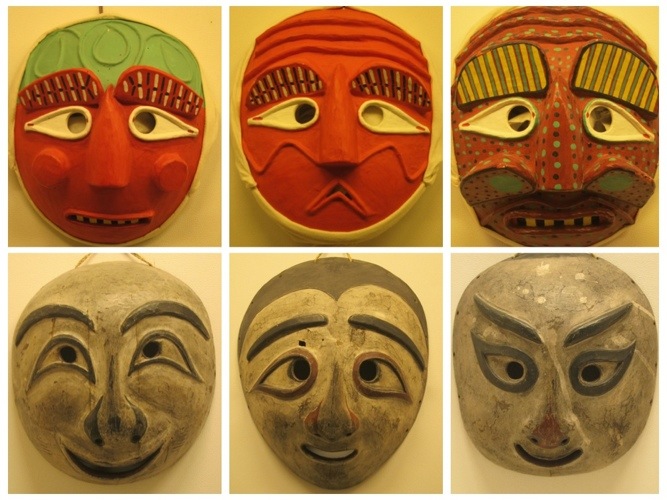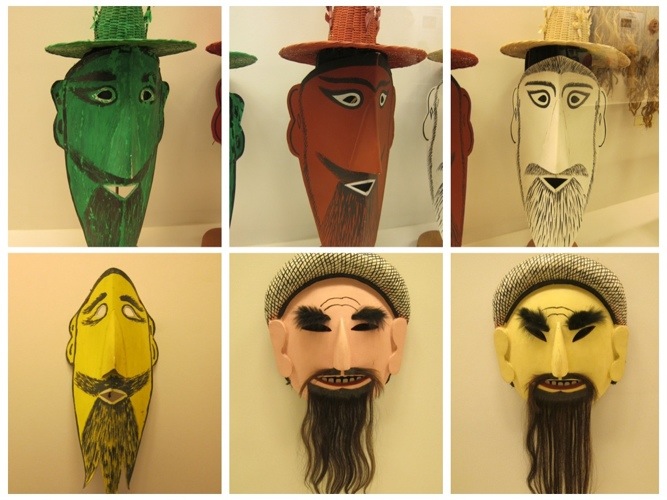Hahoe village and the masks of Korea, and a bit about the Comma-shaped symbols found in Korea
Hahoe village is a UNESCO World Heritage site, surrounded by farmland, on the outskirts of Andong city.
When I researched the area on the internet at home, I did not expect Andong to be such a big and busy city.
I saw the words “Hahoe Folk Village” and “Andong Village” used in many descriptions, so I chose to stay overnight in what I thought to be “Andong Village” but turned out to be a somewhat large city, and not a village at all.
The only Andong Village that exists is a village in the middle of Andong city, that was relocated when they built the Andong Dam where it used to be.
We drove to see the historic Hahoe village, and we visited the mask museum, which was a wonderful experience for someone like me, who loves the artistry and charm of masks.
The museum has an extensive collection of much more than traditional Korean masks.
It houses an impressive collection of masks from around the whole world.
Some of those masks were absolutely jaw-droppingly gorgeous, but I did not include any photos of them in this post.
All the masks featured in this post are traditional masks from around Korea.
Masks were mostly used in Korea for ceremonies like funerals and for public plays, in which the actors played with masks on their faces to educate the people, to tell famous traditional stories, or as a satire, to shine light about life, to encourage people to think, to laugh at the hardships and the comedy of life, and to promote greater awareness.
The masks portray corrupt monks, old ladies, aristocrats, shoe makers, idiots, old hermits, married wives, scholars, butchers, bachelors, servants, low-grade government officials, etc.
Some of the mask dances are still performed today, but mostly during annual events.
The dances that are Performed a few times per week are mostly for the tourists.
It was early evening when we went for a stroll around the historic Hahoe Village.
All the tour buses were already gone, and only a handful of tourists remained in the village.
The village had traditional Hanoks, many with thatched roofs on them, as they have stood for hundreds of years.
The walls of a Hanok’s traditional house were made with the local adobe mud, which glowed in deep pink, red and orange colors, as the rays of the sunset shone gently on it.
Behind the exterior walls, every house was like a charming compound, consisting of a few buildings, a garden, sometimes a pond, and often a uniquely shaped old tree.
As we strolled around the narrow streets, we came upon a charming Hanok and started a conversation with a man from Belgium who was sitting on the porch of this Hanok, where he was staying.
I was regretful that we had not booked a Hanok in this village also.
Our hotel in Andong city was fine, with a comfortable king bed and a mattress which, although hard, as are all the beds in Korea, was still much more comfortable than sleeping on the floor….
Yet, I am NOT seeking comforts and luxury…. I am seeking authenticity and unique experiences…. And I would have liked to stay in the room next to this couple from Belgium, who like us, also love to travel the world and do it often.
They have traveled to many of the places that we have visited as well.
But I did not feel much remorse over our hotel.
I knew that the very next day we have booked an Andol room (a room with a heated floor where you sleep on the floor) in a small Hanok, at another historic UNESCO village in the area, Yangdong village.
The Yu clan established Hahoe Folk Village in the 16th century, during the Joseon Dynasty.
It has been a one-clan community since that time.
The village maintains the old Joseon architectural style that has been lost around the rest of Korea, because of decay and rapid modernization.
The servants’ quarters were usually more humble, and had thatched roofs, while the aristocracy lived in houses which had beautiful clay tile roofs.
The village felt harmonious, and without all the tourists, quiet.
There is an ‘S’ shaped river that runs around and through the Hahoe village, which gave the village its name.
Ha means ‘River’ and Hoe means ‘Turning Around’
The ‘S’ shaped Nakdong River is not the only thing that is believed to bless this village and add harmony to its location.
The village is situated at the foot of a mountain, and it was organized around the guidelines of “Pungsu” (Feng-Shui in Chinese), so the village has the shape of a lotus flower that closes its petals every night, or you can say that the village is shaped like two interlocking comma shapes (similar to the Yin and the Yang symbols).
These Comma shapes are very early symbols, used in jewelry and patterns found in Korea and other parts of Asia for thousands of years.
We saw these comma shaped symbols made of jade or crystal beads, decorating royal gold crowns, earrings, pendents and necklaces.
Those comma-shaped beads, or cashew shaped symbols, are called in Korean, “Gogok.”. (“Gogok” is also sometimes called “Kogok” and “Kokkok”).
These symbols are also found in China and other parts of Asia, but are most numerous in Korea and in Japan (in the Japan they are known as “Magatama”).
This unique shape of a sphere with a flowing tail is believed to be an early visual representation of the human Spirit.
Some say that it is in the shape of an oval seed, symbolizing germination of the Spirit to grow into all possibilities, much like the human Spirit, when one finally remembers her Oneness with all things….
Others say that those shapes are reminiscent of a “drop,” perhaps a “A life-giving rain drop…” or “A drop in the ocean of life…”
And yet others theorize that the comma shapes have much similarity to the nails of a bear, and that the origin of these symbols actually date earlier, to prehistoric times.
In prehistoric times, wearing bear nails meant that you had killed the bear, and therefore that you were strong, and a powerful warrior.
The exact origin is uncertain.
Those comma shapes, or the sphere with a flowing tail, are also used in the well-known symbol of the Yin and the Yang circle.
Two of the shapes complete each other into a circle, and are known to symbolize unity, harmony and infinity.
You can take your own pick at to the interpretation of the shapes of these symbols.
All I can say is that it is the most commonly used symbol in all the early Silla period jewelry found and excavated around Korea.
It was getting dark, and we made our way back to our car.
It was yet again another time in which I was happy to have a car in Korea.
It has made our journey through the country so much easier, and Jules has been doing a fabulous job, maneuvering around the crazy drivers who often do not stop at red lights or speed on narrow small roads.
Having a car has enabled us to explore remote places that we never would have reached, if we were moving by public transport.
At home, when we thought it would be colder in Korea, we overpacked, and now we have repacked our bags and left a lot of clothing in the trunk of the car, so we do not have to lug it in and out of hotel rooms.
Food has been tricky since we left Seoul.
Sometime we have been lucky enough to enjoy a good meal, but often we have had to skip meals because we were traveling, walking or hiking, and there was no place to eat.
We bought some fruit, nuts and roasted Nori seaweed, which we munch when hungry.
We are still getting into the spirit of traveling, still adjusting to busy days full of sights and activities, which are very different from our normal quiet and less busy lifestyle at home.
To me, time flys by in the blink of an eye…
Days, months and even years, blend into a colorful array of memories and feelings….
A reminder that time is yet another illusion… and that it does not really exist.
Beyond the vale of illusions, there is no concept of time…..
We are an immortal Spirit…. and all is well….


























Pingback: Wyjść z twarzą z sytuacji bez wyjścia | Made in Cosmos